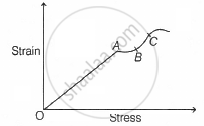Advertisements
Advertisements
प्रश्न
A load of 10 kg is suspended by a metal wire 3 m long and having a cross-sectional area 4 mm2. Find (a) the stress (b) the strain and (c) the elongation. Young modulus of the metal is 2.0 × 1011 N m−2.
उत्तर
Given:
Mass of the load (m) = 10 kg
Length of wire (L) = 3 m
Area of cross-section of the wire (A) = 4 mm2 = 4.0 × 10−6 m2
Young's modulus of the metal Y = 2.0 × 1011 N m−2
(a) Stress = F/A
F = mg
= \[10 \times 10\] = 100 N (g = 10 m/s2)
\[\therefore \frac{F}{A} = \frac{100}{4 \times {10}^{- 6}}\]
\[ = 2 . 5 \times {10}^7 \text{ N/ m }^2\]
(b) Strain = \[\frac{\Delta L}{L}\]
Or,
\[\text{ Strain } = \frac{\text{ Stress }}{Y}\]
\[\text{ Strain }= \frac{2 . 5 \times {10}^7}{2 \times {10}^{11}}\]
\[ = 1 . 25 \times {10}^{- 4} \text{ N/ m}^2\]
(c) Let the elongation in the wire be \[∆ L\] .
\[\text { Strain} = \frac{\Delta L}{L}\]
\[ \Rightarrow \Delta L = \left( \text{ Strain } \right) \times L\]
\[ = 1 . 25 \times {10}^{- 4} \times 3\]
\[ = 3 . 75 \times {10}^{- 4} \text{ m}\]
APPEARS IN
संबंधित प्रश्न
Determine the volume contraction of a solid copper cube, 10 cm on an edge, when subjected to a hydraulic pressure of 7.0 ×106 Pa.
A mild steel wire of length 1.0 m and cross-sectional area 0.50 × 10–2 cm2 is stretched, well within its elastic limit, horizontally between two pillars. A mass of 100 g is suspended from the mid-point of the wire. Calculate the depression at the midpoint.
The ratio stress/strain remain constant for small deformation of a metal wire. When the deformation is made larger, will this ratio increase or decrease?
When a block a mass M is suspended by a long wire of length L, the elastic potential potential energy stored in the wire is `1/2` × stress × strain × volume. Show that it is equal to `1/2` Mgl, where l is the extension. The loss in gravitational potential energy of the mass earth system is Mgl. Where does the remaining `1/2` Mgl energy go ?
When the skeleton of an elephant and the skeleton of a mouse are prepared in the same size, the bones of the elephant are shown thicker than those of the mouse. Explain why the bones of an elephant are thicker than proportionate. The bones are expected to withstand the stress due to the weight of the animal.
A steel blade placed gently on the surface of water floats on it. If the same blade is kept well inside the water, it sinks. Explain.
A rope 1 cm in diameter breaks if the tension in it exceeds 500 N. The maximum tension that may be given to a similar rope of diameter 2 cm is
A wire can sustain the weight of 20 kg before breaking. If the wire is cut into two equal parts, each part can sustain a weight of
A heave uniform rod is hanging vertically form a fixed support. It is stretched by its won weight. The diameter of the rod is
A charged particle is moving in a uniform magnetic field in a circular path of radius R. When the energy of the particle becomes three times the original, the new radius will be ______.
Modulus of rigidity of ideal liquids is ______.
The maximum load a wire can withstand without breaking, when its length is reduced to half of its original length, will ______.
Consider a long steel bar under a tensile stress due to forces F acting at the edges along the length of the bar (Figure). Consider a plane making an angle θ with the length. What are the tensile and shearing stresses on this plane

- For what angle is the tensile stress a maximum?
- For what angle is the shearing stress a maximum?
The value of tension in a long thin metal wire has been changed from T1 to T2. The lengths of the metal wire at two different values of tension T1 and T2 are l1 and l2 respectively. The actual length of the metal wire is ______.
If 'S' is stress and 'Y' is young's modulus of the material of a wire, the energy stored in the wire per unit volume is ______.
A body of mass m = 10 kg is attached to one end of a wire of length 0.3 m. The maximum angular speed (in rad s-1) with which it can be rotated about its other end in the space station is (Breaking stress of wire = 4.8 × 107 Nm-2 and the area of cross-section of the wire = 10-2 cm2) is ______.
The stress-strain graph of a material is shown in the figure. The region in which the material is elastic is ______.

Answer in one sentence:
What is an elastomer?
